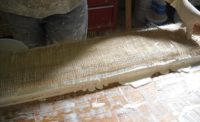It's Clay Time!
An Overview Of The Clay Material Used By Plaster Artisans.




Clay is a simple word for a very complex material. Perhaps one of the first thoughts that comes to mind are dishes and bowls for eating on, terracotta pots for putting plants in, and most importantly, mugs for drinking coffee. If you happen to work drilling holes searching for mineral and other resources you might know how clay is essential to the process as it carries particles up away from the bit, all the while providing lubrication that reduces heat and friction at the same time it speeds along the process.
Perhaps a largely overlooked yet widespread use is as a raw material forming the basis of many building techniques around the world, from adobe homes in the Southwestern United States to cob homes throughout the British Isles. Clay has been formed into bricks and fired for building blocks throughout history and that tradition continues in contemporary construction. As architectural terracotta it can take on utilitarian functions such as pipes for drains or it can show off its artistic potential in elaborate forms to decorate our building façades. All of this variety is contained within a material represented by a single word: Clay. And yet what is it that allowed this humble material to be utilized for so many distinct functions and elaborated into so many different forms? When the material is looked at closely, a very diverse world opens before us.
Where Does Clay Come From?
Clay is quite simply eroded rocks with high levels of aluminosilicate minerals in its basic composition. Basalt and granite are two such examples of the type of source rocks for clay. When these materials over long periods of geologic time under natural processes are ground down into extremely fine particles, changes begin to happen that shift their internal composition and crystalline structure.
In addition to the physical action to erode the rock, the environment of the final resting place of the agglomerated minerals also determines the outcome of the new clay material. The pH and ionic particles surrounding the new structures will replace minor particles and cause subtle adjustments to its physical makeup. Within these varied shifts there are two main crystal structures that form: a 1:1 structure or T-O and the 2:1 structure or T-O-T. These relate to tetrahedral (T-”four-sided”) and octahedral (O-”eight-sided”) layers respectively that make up the clay molecule. These base molecules then bond together to form larger crystalline structures. Additional minerals sometimes found in the layers and subtle variances in the arrangement of the atoms will combine with and influence the base structure to determine the resultant properties of the particular clay material which can be quite varied.
This wide variation of structure that can be achieved from a single material can be well illustrated by another familiar element: Carbon. We’ve come to understand that from the single element of carbon one molecular matrix forms the relatively common and soft graphite, yet another organizes itself into the rare and highly crystalline form we know as diamonds. Both materials are carbon at the elemental, chemical level but the arrangement of the atoms and other inclusions in the composition provides for very different physical properties between them. That correspondence has even made its way into popular culture with singer/songwriter Jim White’s ballad “Diamonds to Coal.”
Something similar holds true for the makeup of clays. For example, the highly abundant clay, Kaolinite has a crystal formation that arranges itself as a flat sheet whereas another clay, Halloysite, having the same elemental composition, organizes itself into tubular crystal structures known as nano-tubes. In both cases, internal structure results in distinct physical properties of the two clays and subsequently divergent applications as building materials.
The Different Clays and their Use in Plastering
The structural composition of clay can be conveniently divided into three main classes: Kandites, Smectites, and Illites. Within each of these main classifications of clay, there are many different mineral variations that comprise each group. Some of them provide us with the qualities needed to make a plaster, and many of them do not.
The Smectite group maintains a 2:1 or T-O-T octahedral structure that absorbs water between their layers of crystalline structure as well as between the crystals themselves. This addition has them be known as “expanding” clays which is not a quality that is typically considered advantageous as a building material. As you might imagine the hydrophilic properties that lead to the massive expansion of the material result in a large rate of shrinkage and friability when the water evaporates. However, it does have its uses. One variety in particular, Bentonite is commonly used as a lubricant in drilling and to seal the bottom of water retention ponds.
Clays belonging to the Illite group have a similar 2:1 structure to the Smectite group; however, Illites aren’t classified as expanding clays because of additional particles within the crystal layers. These additional particles tend to lock out the water molecules from entry between the layers and thus prevents the clay from expansion.
The most common clay of the third Kandite group is Kaolinite (aka kaolin). Kaolin is characterized by a 1:1 or T-O, tetrahedral structure. These sheets form flat, plate-like crystals that don’t absorb between the layers, but do bring water molecules between the crystals at the edges of the molecules.
Because the water is not pulled between the individual layers, it is not considered an expanding clay. This type of bonding holds the molecules together in a gel-like matrix providing for a very pliable material that allows us to readily form kaolin clay into shapes as well as apply as a plaster to other surfaces.
When considering an earthen, that is to say a clay-based plaster there are certain qualities that should be considered. As with plaster generally, it needs to form a ductile mix when wet, readily attach itself to a surface when troweled on and will subsequently dry to a firm continuous surface. In other words, we want a clay plaster that is the perfect compromise between easy to work and sticky but not prone to shrinkage. Therefore, clays from the non-expanding Illite and especially Kandite groups largely prove the most effective and have been the most utilized in earthen architecture and clay-based plasters worldwide.
Nevertheless, sometimes a natural or artificial inclusion of a very small percentage from the Illite group will drastically improve work-ability of the plaster. In addition to the particular clay or blend selected, the type and quantity of additives such as aggregates and fiber becomes very important, contributing both to the ease of application, the quality of finish and long-term performance to the clay plaster.
Below is a brief recap of useful nomenclature surrounding the clays we’ve just considered:
Terra Cotta: literally Italian for earth, “terra” that has been baked, “cotta”. Clay that is fired is used for pottery and sculpture but also major building components such as pipes, bricks and roofing tiles
Aluminosilicate: refers to a large group of minerals mainly composed of silicon compounds where aluminum compounds form a minor percentage
Kandite: a group of non-expanding clays characterized by a 1:1 or T-O, tetrahedral structure
Smectite: a group of highly expansive clays characterized by a 2:1 or T-O-T octahedral structure that absorbs water between their layers of crystalline structure as well as between the crystals themselves.
Illite: a group of non-expanding clays characterized by a 2:1 or T-O-T octahedral structure that locks out the water molecules from entry between the layers and thus prevents the clay from expansion.
Kaolinite: a Kandite clay with a broad range of construction applications including as a plaster binder
Halloysite: a Kandite clay commonly used in porcelain
Bentonite: a Smectite clay commonly used as a lubricant in drilling and to seal the bottom of water retention ponds
Croft Elsaesser contributed to this article.
Looking for a reprint of this article?
From high-res PDFs to custom plaques, order your copy today!








